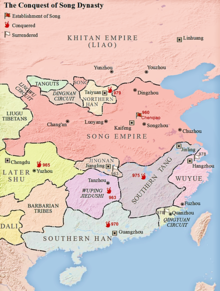
The 10th century was the period from 901 through 1000 (M) in accordance with the Julian calendar, and the last century of the 1st millennium.

A flamethrower is a ranged incendiary device designed to project a controllable jet of fire. First deployed by the Byzantine Empire in the 7th century AD, flamethrowers saw use in modern times during World War I, and more widely in World War II as a tactical weapon against fortifications.

Military technology is the application of technology for use in warfare. It comprises the kinds of technology that are distinctly military in nature and not civilian in application, usually because they lack useful or legal civilian applications, or are dangerous to use without appropriate military training.

A fire ship, or fireship, used in the days of wooden rowed or sailing ships, was a ship, filled with gunpowder or other combustibles, deliberately set on fire and steered into an enemy fleet, in order to destroy ships, or to create panic and make the enemy break formation. Ships used as fire ships were either warships whose munitions were fully spent in battle, surplus ones which were old and worn out, or inexpensive purpose-built vessels rigged to be set afire, steered toward targets, and abandoned quickly by the crew.

Early thermal weapons, which used heat or burning action to destroy or damage enemy personnel, fortifications or territories, were employed in warfare during the classical and medieval periods.
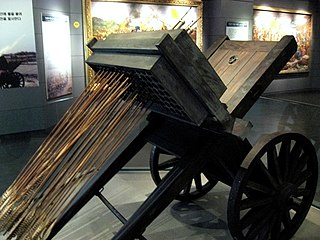
The hwacha or hwach'a was a multiple rocket launcher and an organ gun of similar design which were developed in fifteenth century Korea. The former variant fired one or two hundred rocket-powered arrows while the latter fired several dozen iron-headed arrows or bolts out of gun barrels. The term was used to refer to other war wagons or other cart-based artillery in later periods, such as that developed by Byeon Yijung in the 1590s.
The Battle of Lake Poyang was a naval conflict which took place between the rebel forces of Zhu Yuanzhang and Chen Youliang during the Red Turban Rebellion which led to the fall of the Yuan dynasty. Chen Youliang besieged Nanchang with a large fleet on Lake Poyang, one of China's largest freshwater lakes, and Zhu Yuanzhang met his force with a smaller fleet. After an inconclusive engagement exchanging fire, Zhu employed fire ships to burn the enemy tower ships, and destroyed their fleet. This was the last major battle of the rebellion prior to the rise of the Ming dynasty.
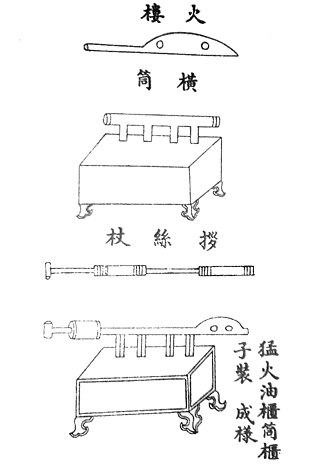
The Fierce-fire Oil Cabinet was a double-piston pump naphtha flamethrower first recorded to have been used in 919 AD in China, during the Five Dynasties and Ten Kingdoms period.

The Song dynasty invented some technological advances in Chinese history, many of which came from talented statesmen drafted by the government through imperial examinations.
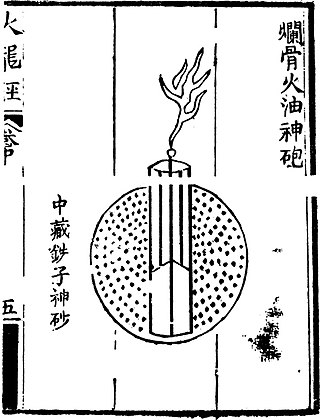
Jiao Yu was a Chinese military general, philosopher, and writer of the Yuan dynasty and early Ming dynasty under Zhu Yuanzhang, who founded the dynasty and became known as the Hongwu Emperor. He was entrusted by Zhu as a leading artillery officer for the rebel army that overthrew the Mongol Yuan dynasty, and established the Ming dynasty.

The Huolongjing, also known as Huoqitu, is a Chinese military treatise compiled and edited by Jiao Yu and Liu Bowen of the early Ming dynasty (1368–1683) during the 14th-century. The Huolongjing is primarily based on the text known as Huolong Shenqi Tufa, which no longer exists.
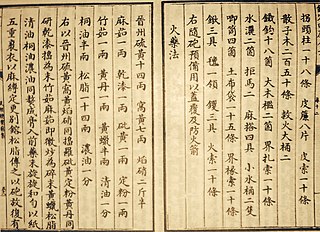
The Wujing Zongyao, sometimes rendered in English as the Complete Essentials for the Military Classics, is a Chinese military compendium written from around 1040 to 1044.
The Battle of Langshan Jiang, or the Battle of Langshan River, was a riverine battle which occurred in 919 during the Five Dynasties and Ten Kingdoms period in China between the dynastic states of Wuyue and Yang Wu.
Song poetry refers to Classical Chinese poetry of or typical of the Song dynasty of China (960–1279). The dynasty was established by the Zhao family in China in 960 and lasted until 1279.
Gunpowder weapons in the Song dynasty included fire arrows, gunpowder lit flamethrowers, soft shell bombs, hard shell iron bombs, fire lances, and possibly early cannons known as "eruptors". The eruptors, such as the "multiple bullets magazine eruptors", consisting of a tube of bronze or cast iron that was filled with about 100 lead balls, and the "flying-cloud thunderclap eruptor", were early cast-iron proto-cannons that did not include single shots that occluded the barrel. The use of proto-cannon, and other gunpowder weapons, enabled the Song dynasty to ward off its generally militarily superior enemies—the Khitan led Liao, Tangut led Western Xia, and Jurchen led Jin—until its final collapse under the onslaught of the Mongol forces of Kublai Khan and his Yuan dynasty in the late 13th century.
The siege of De'an (德安之戰) was fought as part of the Jin-Song Wars of China in 1132, during the Jin invasion of Hubei and Shaanxi. The battle between the besiegers, a group of rebels led by Li Heng and the Song Chinese defenders is important in global history as the first recorded instance of the fire lance, an early ancestor of firearms, being used in battle.

This is an overview of Chinese siege weapons.

The military history of the Five Dynasties and Ten Kingdoms covers the period of Chinese history from the collapse of the Tang dynasty in 907 to the demise of Northern Han in 979. This period of Chinese history is noteworthy for the introduction of gunpowder weapons and as a transitional phase from the aristocratic imperial system to the Confucian bureaucracy which characterized the Song, Ming, and Qing dynasties.
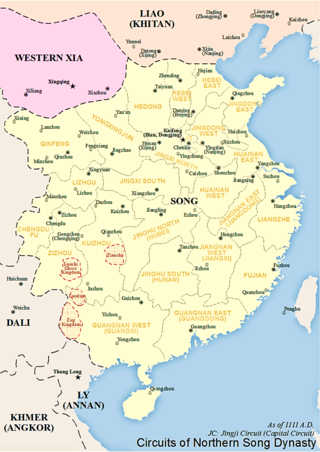
The military history of the Song dynasty encompasses military activity of the Han Chinese state of Song from 960 AD with the overthrow of Later Zhou until 1279 AD when China was conquered by the Mongol-led Yuan dynasty.
